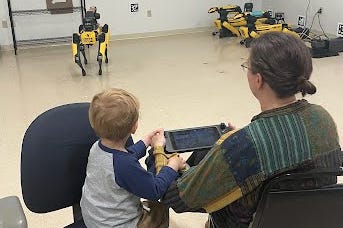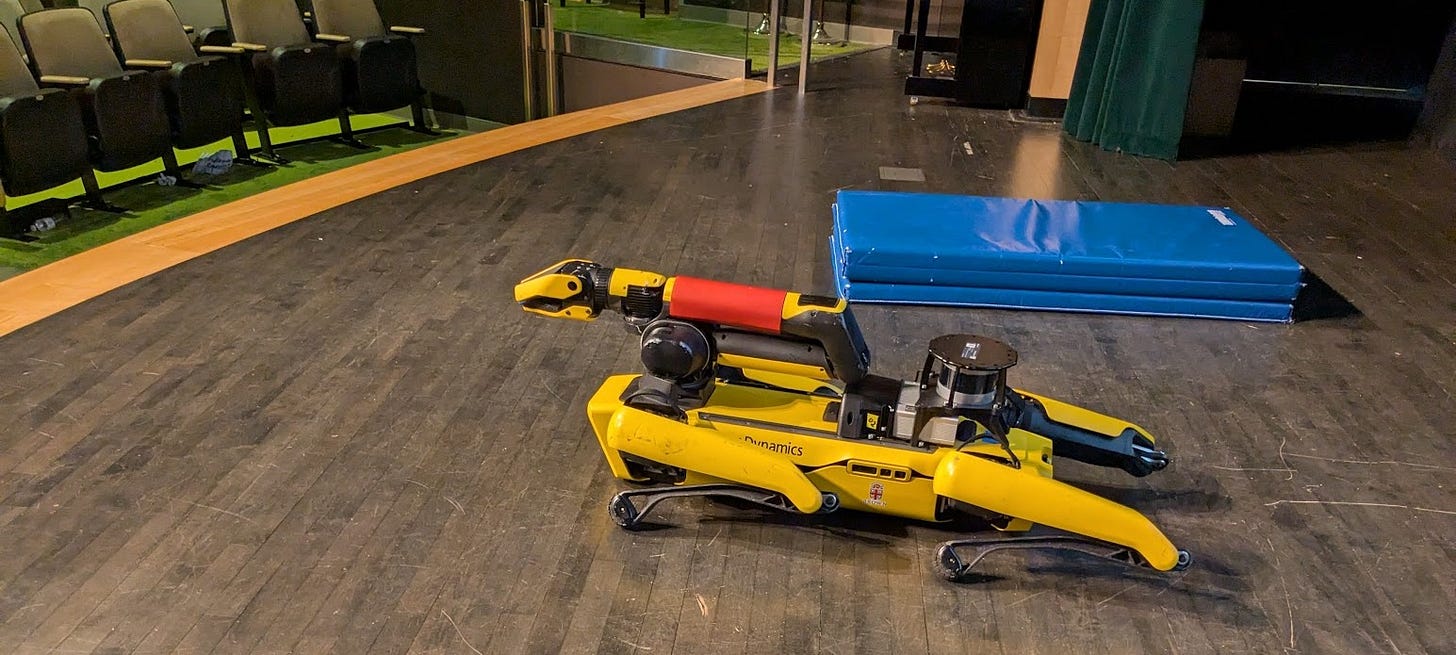Taking a Quadruped Robot to School
There are seven senses, not five.
This Spring I took one of the Spot robots from my lab at Brown to seven schools, and a library. The ages ranged from toddlers at the three-year-old's daycare to middle- and high- school students. It's super fun to be the "robot Mom" and I've been taking robots to my sons' schools (and my sons’ friends to the robots) since the oldest was an infant. (Shout-out to the Sony Aibo 1!) Kids are so excited to see the robot, a few are sometimes scared of it, and all of them love the "butt camera" that helps Spot move backwards.
Spot is one of the most advanced robots in the world, and taking it to a school is a fundamentally different experience from any other robot. When we first got two Spots for my lab in, I was worried they would be paperweights because they would be breaking or falling all the time. Instead, they became the most desired, stable, and powerful platform we had for mobile manipulation, and my students quickly migrated to Spot from our Movo wheeled mobile manipulator. It's a rock solid platform, and it's easy to take its capabilities for granted, because it's so deceptively robust. We are so used to seeing people and animals locomote all around us, that sometimes the kids don't appreciate the complexity of the stack they are seeing. And of course, as I learned a long time ago doing robot demonstrations, autonomy is boring. Kids love nothing more than driving the robot.
When we talk about a robot like Spot, it's useful to appreciate the sensors, actuators, and compute that enable it to do what it does. For kids, I start by talking about the five senses, but actually the five senses are not very important to Spot. It doesn't have a microphone (by default, anyway; my lab just installed a directional mic), it doesn't have tactile sensing (but my lab just released a model that uses the existing joint sensors to localize touch to within about 10cm). No nose or taste unless you buy and install one. Vision though - well it has 6 or 12 cameras depending on how you count - if you count the RGB and infrared cameras as one camera (since it's often processed as one sensor stream - RGB-D) or two (since there are, actually two cameras inside the package).
Spot uses the cameras for obstacle avoidance and footstep planning, but it could walk just fine without them. The most important two sensors for Spot aren't any of the five, and kids are often surprised to hear this. (The three-year-old’s physical therapist was not surprised!) The vestibular system, which in robotics is an IMU or inertial measurement unit. This is your sense of balance, your sense of what way is down, and how you are turning or spinning. I ask kids to imagine riding a train, with their eyes closed, it's the sense that lets them tell when the train is stopping or going. And the proprioception syste
m, the sense of where your body is in space. I ask the kids to hold hands with a friend, and close their eyes, and ask the friend to raise their hand, and then lower it. They can tell, even with their eyes closed, where their hand is in space. Similarly, Spot uses joint encoders to tell where its arm and legs are located relative to its body. It's these two sensors - the IMU and joint encoders, that are fundamental to the robot's ability to walk and balance.
What strikes me most about these school visits is how naturally kids transition from wonder to understanding. They start by being amazed that a robot can walk at all, then quickly become curious about how it works, and finally want to take control themselves. By the end of each visit, they’re asking sophisticated questions about sensors and programming, suggesting new things Spot could do, and discussing issues of robotics and society. These demonstrations remind me why I love robotics: it’s not just about building impressive machines, but about inspiring the next generation to think creatively about technology.





